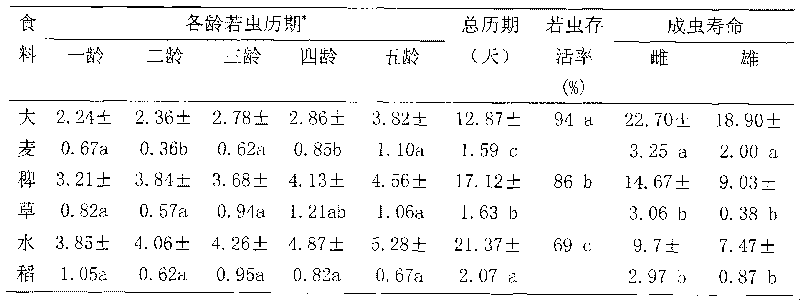Method for raising small brown rice planthopper by utilizing soil-less cultured barley seedling
A technology of SBPH and barley seedlings, applied in the fields of application, seed and rhizome treatment, agriculture, etc., can solve the problems of not being easy to raise large quantities of SBPH, inconvenient transfer of adult nymphs, inconvenient operation, etc., to reduce the cost of changing barley seedlings The number of times, ensuring a large number of standard insect sources, and reducing the effect of natural death
- Summary
- Abstract
- Description
- Claims
- Application Information
AI Technical Summary
Problems solved by technology
Method used
Image
Examples
Embodiment 1
[0022] (1) Cultivate barley seedlings: take the plump barley seeds and use carbendazim wettable powder with a weight concentration of 50% first, and sterilize the seeds by dressing them at 0.3% of the weight of the seeds for 4 hours, then rinse them with clean water, and pour them into the shop. Cover the cultured ceramic tray with moist absorbent paper, cover it with gauze, and place it in a light incubator at a temperature of 28°C to accelerate germination. After 2 days, use tweezers to pick out the white barley seeds, and put them into the wide mouth that has been covered with two layers of moist absorbent paper. In the bottle, it is advisable to cover the bottom of the bottle. Pay attention to leaving a certain gap between the seeds. After planting, cover the bottle mouth with gauze and fix it with a rubber band. Continue to put it in the bottle at a temperature of 28°C, a relative humidity of 70%, and a light time of 12 hours. , in a light incubator with a light intensity ...
Embodiment 2
[0027](1) Cultivation of barley seedlings: take the plump barley seeds first with 75% thiophanate-methyl wettable powder, and sterilize the seeds by dressing 0.05% of the weight of the seeds for 8 hours, rinse with clear water, pour into In a culture ceramic plate covered with moist absorbent paper, covered with gauze, placed in a light incubator with a temperature of 25 ° C to promote germination. After 2 days, use tweezers to pick out the white barley seeds and put them in a wide area that has been covered with two layers of moist absorbent paper. In the bottle, it is advisable to cover the bottom of the bottle, and pay attention to leave a certain gap between the seeds. After planting, cover the mouth of the bottle with gauze and fix it with a rubber band. Continue to put it in the temperature of 25 ° C, the relative humidity of 80%, and the light time of 14 hours, in a light incubator with a light intensity of 5500 LUX, for about 5 days, when the barley grows to 4-5 cm, it ...
Embodiment 3
[0032] (1) Cultivation of barley seedlings: take the plump barley seeds first with 75% thiophanate-methyl wettable powder, and sterilize the seeds by dressing seeds at 0.2% of the weight of the seeds for 6 hours, rinse with water again, pour into In a culture ceramic plate covered with moist absorbent paper, covered with gauze, and placed in a light incubator with a temperature of 22 ° C for germination. In the bottle, it is advisable to cover the bottom of the bottle, and pay attention to leave a certain space between the seeds. After planting, cover the mouth of the bottle with gauze and fix it with a rubber band. Continue to put it in the temperature of 22 ° C, the relative humidity of 90%, and the light time of 16 hours, in a light incubator with a light intensity of 5000LUX, about 5 days, when the barley grows to 4-5cm, it is used to raise the SBPH;
[0033] (2) Raising the nymphs of the SBPH: put the newly hatched nymphs of the SBPH into the wide-mouthed bottle of the cu...
PUM
 Login to View More
Login to View More Abstract
Description
Claims
Application Information
 Login to View More
Login to View More - R&D
- Intellectual Property
- Life Sciences
- Materials
- Tech Scout
- Unparalleled Data Quality
- Higher Quality Content
- 60% Fewer Hallucinations
Browse by: Latest US Patents, China's latest patents, Technical Efficacy Thesaurus, Application Domain, Technology Topic, Popular Technical Reports.
© 2025 PatSnap. All rights reserved.Legal|Privacy policy|Modern Slavery Act Transparency Statement|Sitemap|About US| Contact US: help@patsnap.com


